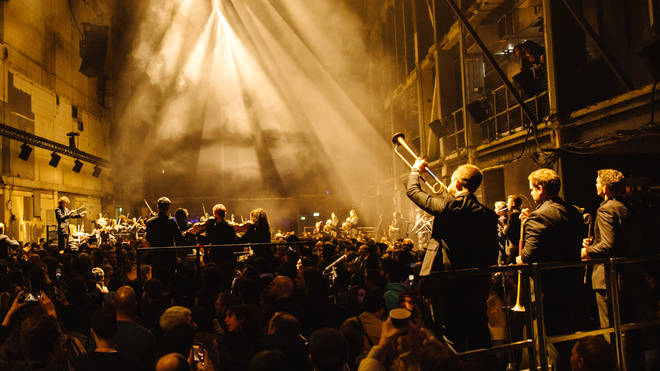It's all about the classical music composers and their works from the last 400 years and much more about music. Hier erfahren Sie alles über die klassischen Komponisten und ihre Meisterwerke der letzten vierhundert Jahre und vieles mehr über Klassische Musik.
Total Pageviews
Tuesday, April 4, 2023
Monday, April 3, 2023
Johann Nepomuk Hummel - Piano Concerto No. 2 in A minor, Op. 85 (1816)
Legendary Cuban songwriter, composer and pianist gained world fame
Cuban-born, Ernesto Lecuona is the dominant musical force to have come out of the island nation, and without question one of the major contributors to the emergence of Latin music as a power in the world marketplace. Often called 'the Gershwin of Cuba,' he was friendly with George Gershwin and with the composer Maurice Ravel, who once called Lecuona's immortal "Malaguena," "more melodic and beautiful than my own "Bolero." Lecuona was friendly with many of the most influential composers and musical personalities of his moment in time, and his style and use of forms have influenced all Latin music, even the salsa of today.
Ernesto Lecuona was born in Guanabacoa, Cuba, across the bay from Havana, on August 6, 1895, but for an unexplained reason he actually observed his birthday as August 7, 1896. His musical talent was already discernible at age three. Following initial piano studies with his sister, Ernestina, he continued at the Conservatorio Peyrellade with Antonio Saaverda and the famed Joaquin Nin. At 17 he graduated from the National Conservatory of Havana with a gold medal in performance.
He had become a prodigious pianist indeed and his talents were soon on view for the first time outside Cuba when he appeared at Aeolian Hall, New York City in 1916. While his ties to his native Cuba were always strong, this initial performance in New York paved the way for an increasing presence in the United States, both as concert pianist and as composer, which eventually led to his permanent move to Florida in 1960, following the rise to power of the Communist leader, Fidel Castro in 1959.
Lecuona produced a veritable torrent of music during his 70 years, including a number of major pop songs, such as the well-remembered, "Malaguena" the bright and rhythmic, "Siboney," with which one can almost hear the clicking accompaniment of castanets "Always in My Heart" and "Andalucia," better remembered for its Americanized version, “The Breeze and I," which became in the late '30s a popular recording hit by the Jimmy Dorsey Orchestra.
While we honor the late Ernesto Lecuona for his wonderful collection of memorable and tuneful songs, his talents in music-making were literally all over the map. In addition to more than 400 songs, he also created 176 piano pieces, 53 theater works (zarzuelas, operettas, theatrical revues and an opera), 31 orchestral scores, 6 pieces for piano and orchestra, 3 violin works, a trio, 5 ballets, 11 film scores and many incidental arrangements.
Lecuona's work stretched considerably beyond the printed score sheet. He was the co-founder of the Havana Symphony Orchestra, the Lecuona Cuban Boys Band and La Orquesta de la Habana. During the '30s and '40s, he was hired to create a number of motion picture scores for MGM, Warner Bros. and 20th Century Fox, and his score for the 1942 Warner Bros. film Always in My Heart was nominated for an Academy Award. At one time he also served as honorary cultural attaché to the Cuban embassy in Washington. He also gave successful performances in Carnegie Hall.
Lecuona, who had moved permanently to Tampa, Florida in 1960, died three years later of a heart attack while on a trip to Santa Cruz de Tenerife in the Canary Islands. He is buried in the Gate of Heaven Cemetery in Hawthorne, NY.
NEVER LET ME GO (2010) - Rachel Portman - Soundtrack Score Suite
Sunday, April 2, 2023
Ralph Vaughan Williams - Fantasia on a Theme by Thomas Tallis
Japanischer Musiker und Komponist Ryuichi Sakamoto gestorben
Der Komponist und Mitglied der Berlinale-Jury, Ryuichi Sakamoto, starb am 28.03.2023
Für seine Musik zum Film „Der Letzte Kaiser“ (1987) wurde er mit einem Oscar und einem Grammy ausgezeichnet. Jetzt ist der japanische Filmkomponist, Musiker, Schauspieler und Produzent Ryuichi Sakamoto tot. Er starb bereits am vergangenen Dienstag im Alter von 71 Jahren.
Der japanische Komponist und Oscar-Gewinner Ryuichi Sakamoto ist im Alter von 71 Jahren gestorben. Sakamoto sei bereits am 28. März einem Krebsleiden erlegen, teilte sein Management am Sonntag mit. Der Musiker war für seine Musik zum Film „Der Letzte Kaiser“ (1987) mit einem Oscar und einem Grammy ausgezeichnet worden.
Der Musiker galt als Pionier elektronischer Musik und Wegbereiter für Musikrichtungen wie Synth-Pop, House-Musik und Hiphop. Bekannt wurde er allerdings für seine Filmmusik, unter anderem auch für den Film „Furyo – Merry Christmas, Mr. Lawrence“ (1983). In dem Kriegsdrama trat er neben seinem Freund David Bowie auch als Schauspieler auf. Das Lied „Forbidden Colours“ wurde zu einem internationalen Hit.
Sakamoto lebte jahrzehntelang in New York. In seiner Heimat Japan war er ein großer Star, war in der Anti-Atombewegung aktiv und gründete 2011 einen Hilfsfonds, um bei der Tsunami-Katastrophe zerstörte Schul-Klaviere zu ersetzen. 2014 überstand er eine Lungenkrebserkrankung. 2015 komponierte er die Filmmusik für „The Revenant – Der Rückkehrer“. 2018 saß Sakamoto in der Jury der Berlinale.
Anfang 2021 erklärte der Musiker dann, er befinde sich wegen Darmkrebs in Behandlung. Sein Management veröffentlichte mit der Todesnachricht am Sonntag eines von Sakamotos Lieblingszitaten: „Die Kunst ist lang, das Leben ist kurz.“
AFP/wolf
Friday, March 31, 2023
Musical Prayers for Peace
By Georg Predota

© National Today
In such times of deep political and ideological crisis, it is once again the musical community calling for an end to hostilities and musically praying for peace. And at the head of the class stands once more the celebrated cellist Yo-Yo Ma, appointed by the United Nations a “Messenger for Peace.” Yo-Yo Ma has been reaching out to people all over the globe, inspiring them to address the many challenging social issues we face today. In a recent concert with the New York Philharmonic, he performed a work that Pablo Casals often played to protest war and oppression.
Pablo Casals (1876-1973) was one of the greatest cellists of the twentieth century. He had to flee his native Spain in 1939 when dictator Francisco Franco took control at the end of the Spanish Civil War. Together with thousands of other refugees, Casals was housed in a refugee camp in France. “Casals spent much of his time delivering food and clothing to fellow refugees, and he continued to aid them throughout his life.”
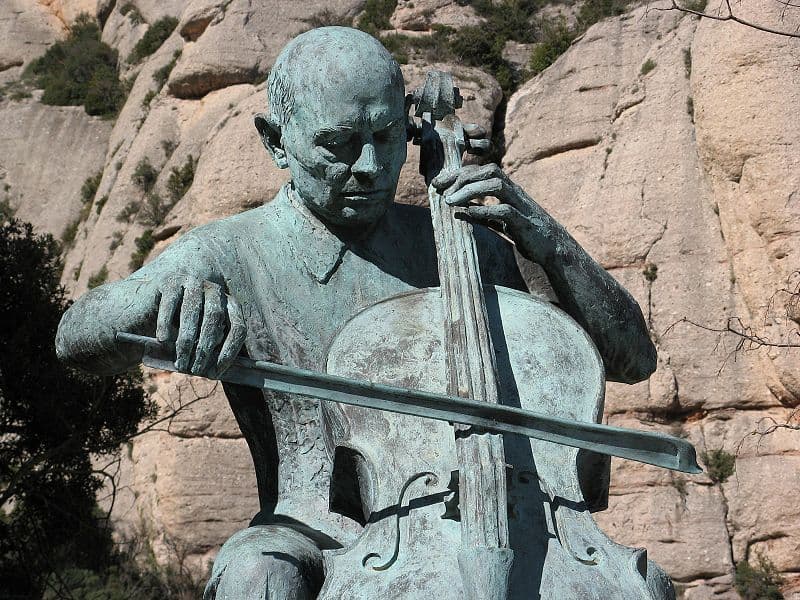
Pablo Casals’ centenary statue
Yo-Yo Ma, at the age of sixteen, played in an orchestra under Casals’ direction. He recalls, “I never forget the way his mind and body would radiate vitality the moment he raised his baton… He saw himself not primarily as a cellist but as a musician, and even more as a member of the human race.” His personal anthem, “The Song of the Birds,” is a traditional Catalan Christmas song and lullaby, and after his exile in 1939, Casals would begin each of his concerts by playing his arrangement for cello.
It might come as a surprise, but the patriotic hymn “Prayer for Ukraine” dates back to 1885, and to a time when Ukrainian culture and language were once again suppressed by the government of Imperial Russia. It has been a very long struggle for independence for Ukraine, as different conquerors have mercilessly fought over this land rich in natural resources and culture. There was a short-lived revolution in 1919 brutally suppressed, and the Soviet occupation inflicted one tragedy after another.
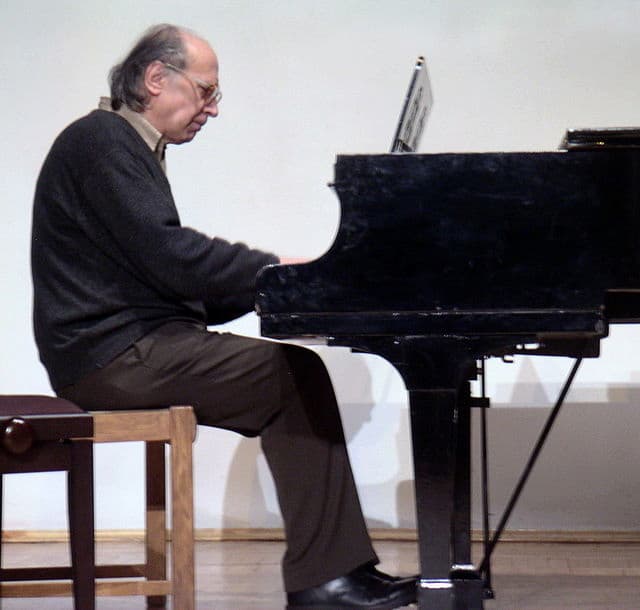
Valentin Silvestrov
During the famine of the 1930s, millions of Ukrainian peasants starved to death because of the criminal policies of Joseph Stalin. The Nazi occupation of Western Ukraine saw the implementation of the “Final Solution,” first applied in cities whose wealth and cultural standing depended entirely on a vast Jewish population. And then there has been this perpetual tug of war over the Crimean Peninsula. Ethnic cleansing at the command of various Russian heads of State was repeated under Stalin, and then once again in 2014 after the Russian occupation. Instead of painting himself as a victim of Western aggression, Vladimir Putin and his shadow puppets should rightfully stand trial for committed war crimes at the International Criminal Court in The Hague.
On 23 February, Anatolii Vasylkovskii took the Ukrainian national chamber ensemble known as the Kyiv Soloists on a regular two-week tour to Italy. One day later, Russian troops invaded Ukraine, and he remembers, “When we arrived in Italy, many of our members phoned their families and heard that there had been bombings.” The focus of the tour changed in an instant, as “we had to spread the message that Ukrainians are peaceful people.” Relying on the solidarity of other ensembles and orchestras, who hosted them in their concert halls and homes, the tour was extended across Europe. Anatolii emphasized, “We want to dedicate these concerts to our families, our country, our army, which are now fighting for the democracy of the whole world.” The Kyiv Soloists want to convey a “message of peace and solidarity with the people of Ukraine and of love for the families and friends they have left behind.” Their performances are no longer simply aimed at cultural exchange and musical enjoyment; they are a form of activism. “Our music-making is now a prayer for peace.”
If I may be permitted, let me add my personal musical prayer for peace by turning to the music of Johann Sebastian Bach. In 1817, a critic called Bach’s Mass in B minor “the greatest work of music in all ages and of all people.”
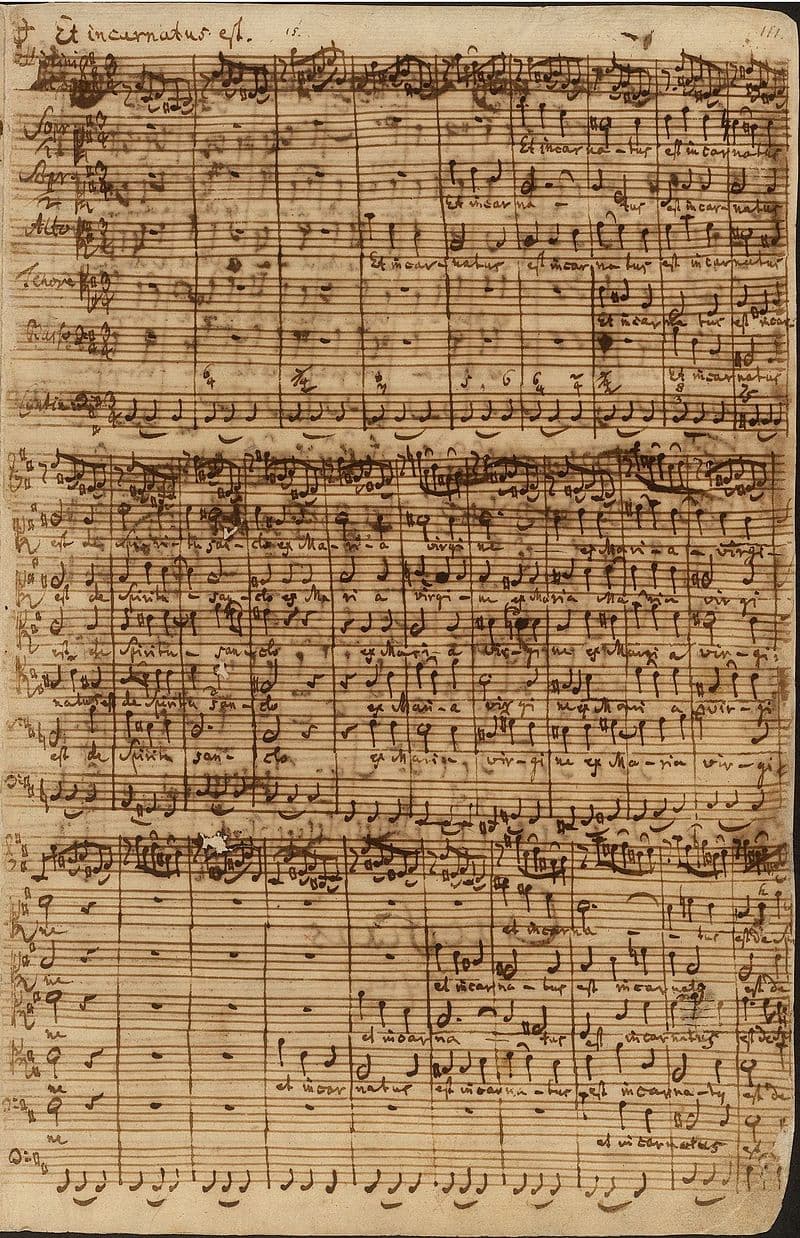
Bach’s B minor Mass, BWV 232
While this kind of assessment might need a bit of clarification, the work is significant because we find a Lutheran composer setting the complete Latin text of the Catholic Mass Ordinary. So, how does a devout Lutheran musically deal with the line in the Creed, “and I believe one holy catholic and apostolic Church?” That particular text receives two melodies sung by the choir simultaneously, and in perfect harmony. One is the traditional melody sung by Roman Catholics, and the other is a Lutheran chorale melody. The language of music, after all, has the distinct ability to console and unite. Let us now join the Bach Collegium Japan in Bach’s short prayer for peace, the “Dona Nobis Pacem” (Grant us Peace) from his B-minor Mass.
Thursday, March 30, 2023
PART4| Filipino Songs that Sound Like Foreign / International (Top 10)
There’s More to Brahms Than You Think
Beethoven’s Symphony No.5 fills Printworks in Aurora Orchestra’s thrilling immersive concert
By Sophia Alexandra Hall
@sophiassocials19th-century orchestral grandeur meets the cavernous Printworks London for an immersive concert experience unlike any other...
Written at the start of the 19th century, Beethoven’s Symphony No. 5 in C minor is one of the best-known works of the classical repertoire.
But arguably, perhaps the best way to experience the work is from the middle of the orchestra, where you can hear every instrument and fully immerse yourself in the soundscape carefully curated by the German maestro.
Often, this is a position only orchestral members themselves get to experience. But in this performance of the composer’s symphonic work, performed on 23 March 2023 by the Aurora Orchestra, 4,000 audience members had a chance to stand in between the 47-strong player ensemble over two evening concerts.
Hosted at Printworks London, a large industrial space which previously housed the printing press for British newspapers, the Daily Mail and Evening Standard, the concert saw the orchestra scattered across an array of platforms in the venue’s cavernous main hall. The audience was then able to move around between each section of the ensemble. Watch a video of the experience below.
In 2021, the Aurora Orchestra performed Beethoven’s Symphony No.7 at the same venue, which drew in an entirely new demographic of audience members to the unique immersive experience.
Asked why these two particular symphonies were chosen for this concert set-up, Jane Mitchell, Aurora’s creative director and principal flautist, told Classic FM: “They felt like really good starting points for us to try this new way of performing – partly because they’re so rhythmical and pack such a punch.
“They have this immediate character to all of the movements and there’s something about that immediacy and that rhythmic energy that infuses both pieces which make them incredibly suitable for this space.”
Principal conductor and founder of the orchestra, Nicholas Collon, added that the most exciting aspect of these concerts is the audience themselves.
“I was surprised by the strength of their response,” Collon told Classic FM. “And that’s partly due to the communal nature of these concerts, and having everyone squashed together.
“Also, as performers, we are already so aware of the power of music, it’s so exciting! But perhaps if you haven’t heard a symphony before, if you haven’t been so close up next to an orchestra, it is an extra thrilling thing to be a part of”.
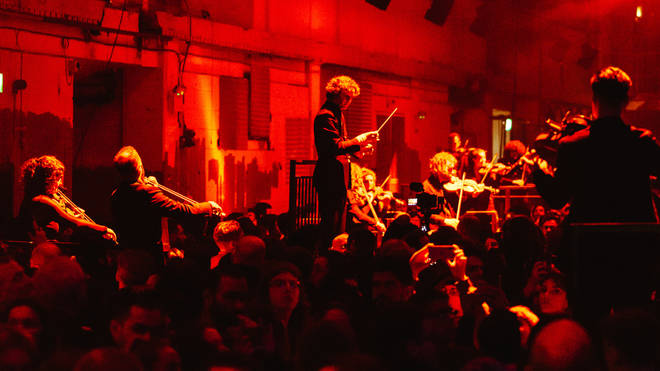
Founded by Collon in 2005, the Aurora Orchestra has developed a reputation for the musicians’ ability to perform concert works entirely by memory, and often in unique and unexpected spaces.
Their audiences tend to differ from the usual demographics found at classical concerts, especially at their recent Printworks performances.
“I would say the demographic of these concerts, to be fair, has been quite clearly younger than your average concert hall,” Collon admitted.
“But regardless of age, it’s amazing how attentive the audience is. Even though as a whole, our attention spans are going down the pan, I think because people get to move around during the movements of the symphony, they get to experience the piece from multiple different angles.
“Perhaps they’ve spent the first movement by double bases, then they might choose to be near the trumpets for the second, and they get a totally different experience!”
Mitchell agrees and echoed: “It’s such an overwhelming experience to be in the middle of an orchestra. I always feel that as a player myself, so I just want the audience to be able to experience that too.
“I think there’s so much about the texture of an orchestra and the immediacy of being right up close with instruments and seeing how the different parts fit together. You just don’t get to experience that in a concert hall when you’re more than five rows back.”
Having the orchestra so spread out, as to allow the audience to travel between the instruments, was a challenge both the musicians and Collon had to adapt to.
“You’re more spaced out than you’d normally be,” Collon explained. “On stage perhaps the entire orchestra would be 20 metres wide, but in Printworks it’s probably more like 100 metres wide.”
To ensure the musicians could hear each other, the orchestra worked with cutting-edge technology provided by Southby Productions and d&b audiotechnik, which meant the orchestra could accurately retain a naturally immersive sound, whilst also ensuring a balance in the overall soundscape.
Interweaved between the movements of Beethoven, the Aurora partnered with composer, Nwando Ebizie who created a selection of electronic music, film and poetry in response to the 19th-century symphonic work.
Read more: Scientific analysis of Beethoven’s DNA reveals he had a high risk of liver disease
“Having Ebizie’s work next to our playing is so special for people to experience,” Mitchell said. “One of my favourite things about this performance, is how the music transitions from the world of electronic music and how that works in this space, to what we’re doing.
“The kind of journey you go on through listening to the Beethoven, she takes you on an almost parallel journey as well.”
While already a special concert in its own right, the performance had an extra tinge of poignancy as the venue Printworks is due to close later this year, the orchestra’s concert being one of its last events.
However, this certainly won’t mean the end of Aurora’s exploration into idiosyncratic performance spaces. As Mitchell reassured, “the production team behind Printworks actually run several buildings like this and we’re very happy to be guided by the building [when planning a concert].
“So if someone shows us a space – it could be an old church or it could be one of these more industrial spaces – we’re interested in responding to that.
“Rather than us dictating what kind of venue we want to perform in, ‘oh it has to be this dimension and have this kind of acoustic’, we actually enjoy the process of walking into a space and going, ‘Okay, what do we do? What’s going to speak here, and how would that work?
“It is a brilliant challenge for us to do that. To work directly with the building itself, and create something that’s really going to resonate with the audience.”


